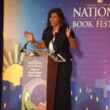March, Book Two
Description
More Details
9781603094016
Subjects
African American legislators -- Biography -- Comic books, strips, etc
African American Nonfiction
African Americans -- Civil rights -- Comic books, strips, etc
Autobiographical comic books, strips, etc
Civil rights movements -- Southern States -- History -- Comic books, strips, etc
Civil rights workers -- United States -- Biography -- Comic books, strips, etc
Comic and Graphic Books
Comic books, strips, etc
History
Legislators -- United States -- Biography -- Comic books, strips, etc
Lewis, John, -- 1940 February 21- -- Comic books, strips, etc
Student Nonviolent Coordinating Committee (U.S.) -- Biography -- Comic books, strips, etc
United States. -- Congress. -- House -- Biography -- Comic books, strips, etc
Young Adult Nonfiction
Similar Series From Novelist
Similar Titles From NoveList
Similar Authors From NoveList
Published Reviews
Booklist Review
*Starred Review* Lewis, Aydin, and Powell's lauded March: Book One (2013) ended with the successful desegregation of Nashville's lunch counters. Book Two, though certainly a continuation of the story, has a markedly different tone, focusing on the dangerous freedom rides in 1961, which incited brutal, hate-filled reactions and splintered some factions of the civil rights movement, as well as the monumental March on Washington in 1963. Continuing their nonviolent action meant facing potentially fatal consequences; Lewis and the freedom riders, for instance, all signed wills before they embarked on their historic ride, and Martin Luther King Jr. himself declined to participate. Powell captures the danger and tension in stunning cinematic spreads, which dramatically complement Lewis' powerful story. In one staggering wordless scene, Aretha Franklin's joyous performance at President Obama's inauguration is overlaid with snapshot glimpses of the bloody, angry aftermath of the freedom rides in Montgomery, Alabama, highlighting both the grand victory represented by Obama's election and the sacrifices many made to achieve it. The story of the civil rights movement is a triumphant one, but Lewis' account is full of nuance and personal struggle, both of which impart an empowering human element to an often mythologized period of history. An important chronicle made accessible both by Powell's expert artwork and Lewis and Aydin's compelling, down-to-earth writing, this is a must-read.--Hunter, Sarah Copyright 2015 Booklist
Publisher's Weekly Review
In the second installment of his graphic memoir, Congressman Lewis continues to lay his soul bare about his time as an activist in the Civil Rights Movement. Chronicling the triumphs and hardships of the Congress of Racial Equality (CORE), this book paints a devastating picture of America in the 1960s, taking to task those who attacked peaceful protestors, and politicians who were desperate to maintain segregation. Lewis, Aydin, and Powell's combined experiences combine to recreate scenes of incredible feeling, from Rev. Martin Luther King's legendary "I Have a Dream" speech (and Lewis's own, oft-overlooked speech on the same day), to a single, terrifying night spent surrounded by the Ku Klux Klan. Even passages that are less emotionally fraught still carry historical import, including Lewis's recollections of private conversations with King. Throughout, however, it is Powell's art that truly steals the show, as the veteran graphic novelist experiments with monochrome watercolors, powerful lettering techniques, and inspired page layouts to create a gripping visual experience that enhances the power of Lewis's unforgettable tale. (Jan.) © Copyright PWxyz, LLC. All rights reserved.
School Library Journal Review
Gr 9 Up-Lewis's training in the non-violence movement is increasingly put to the test as the Freedom Riders are assaulted and black activists splinter along ideological lines. Unflinchingly brutal, this effectively illustrated sequel emphasizes the long fight to attain necessary civil rights, while the culminating March on Washington rings with frustrated compromise and unfinished business. © Copyright 2016. Library Journals LLC, a wholly owned subsidiary of Media Source, Inc. No redistribution permitted.
Library Journal Review
Lewis, Aydin, and Powell (March, Bk.1) continue their best-selling history/memoir of the civil rights movement from Congressman Lewis's perspective. This volume follows Lewis as he takes on leadership positions in the Student Nonviolent Coordinating Committee. The work begins with sit-ins and other protests in Nashville in 1961, but the focus soon shifts to the Freedom Riders, whose courage is vividly portrayed and seems to leap off these pages, as does the hatred and violence that they faced. The actual March on Washington for Jobs and Freedom in August 1963 ends the volume. Excerpts from Alabama governor George Wallace Jr.'s inauguration speech and Lewis's own speech at the march, both in 1963, highlight the vast distance that separated the racism and bigotry on one side and the demands for equality on the other. This story is powerful enough that it could have been illustrated with stick figures and still packed a punch, yet Powell's excellent duotone art nails the emotional range of the characters, from hope and determination to sheer loathing and brutality. Verdict This second volume by the last living member of the march's "Big Six" belongs on the shelf of every library as a testament to the bravery and suffering of all who participated in the civil rights movement.-Eric Norton, McMillan Memorial Lib., Wisconsin Rapids (c) Copyright 2015. Library Journals LLC, a wholly owned subsidiary of Media Source, Inc. No redistribution permitted.
Horn Book Review
In the graphic-memoir trilogy's second volume, dramatic descriptions and vivid black-and-white illustrations follow Lewis through direct action campaigns in Nashville, Freedom Rides into the Deep South, and his speech at the 1963 March on Washington. The account has the authority of a passionate participant; the pacing ramps up tension and historical import. A standout among the many excellent volumes on civil rights. (c) Copyright 2015. The Horn Book, Inc., a wholly owned subsidiary of Media Source, Inc. No redistribution permitted.
Kirkus Book Review
Heroism and steadiness of purpose continue to light up Lewis' frank, harrowing account of the civil rights movement's climactic dayshere, from cafeteria sit-ins in Nashville to the March on Washington.As in the opener, Powell's dark, monochrome ink-and-wash scenes add further drama to already-dramatic events. Interspersed in Aydin's script with flashes forward to President Barack Obama's 2009 inauguration, Lewis' first-person account begins with small-scale protests and goes on to cover his experiences as a Freedom Rider amid escalating violence in the South, his many arrests, and his involvement in the Student Nonviolent Coordinating Committee's formation and later internal strife. With the expectation that readers will already have a general grasp of the struggle's course, he doesn't try for a comprehensive overview but offers personal memories and insightsrecalling, for instance, Martin Luther King Jr.'s weak refusal to join the Freedom Riders and, with respect, dismissing Malcolm X: "I never felt he was a part of the movement." This middle volume builds to the fiery manifesto the 23-year-old Lewis delivered just before Dr. King's "I have a dream" speech and closes with the September 1963 bombing of the 16th Street Baptist Church. The contrast between the dignified marchers and the vicious, hate-filled actions and expressions of their tormentors will leave a deep impression on readers. Lewis' commitment to nonviolentbut far from unimpassionedprotest will leave a deeper one. Backmatter includes the original draft of Lewis' speech. "We're gonna march"oh, yes. (Graphic memoir. 11 up) Copyright Kirkus Reviews, used with permission.
Booklist Reviews
*Starred Review* Lewis, Aydin, and Powell's lauded March: Book One (2013) ended with the successful desegregation of Nashville's lunch counters. Book Two, though certainly a continuation of the story, has a markedly different tone, focusing on the dangerous freedom rides in 1961, which incited brutal, hate-filled reactions and splintered some factions of the civil rights movement, as well as the monumental March on Washington in 1963. Continuing their nonviolent action meant facing potentially fatal consequences; Lewis and the freedom riders, for instance, all signed wills before they embarked on their historic ride, and Martin Luther King Jr. himself declined to participate. Powell captures the danger and tension in stunning cinematic spreads, which dramatically complement Lewis' powerful story. In one staggering wordless scene, Aretha Franklin's joyous performance at President Obama's inauguration is overlaid with snapshot glimpses of the bloody, angry aftermath of the freedom rides in Montgomery, Alabama, highlighting both the grand victory represented by Obama's election and the sacrifices many made to achieve it. The story of the civil rights movement is a triumphant one, but Lewis' account is full of nuance and personal struggle, both of which impart an empowering human element to an often mythologized period of history. An important chronicle made accessible both by Powell's expert artwork and Lewis and Aydin's compelling, down-to-earth writing, this is a must-read. Copyright 2014 Booklist Reviews.
LJ Express Reviews
Lewis, Aydin, and Powell (March, Bk.1) continue their best-selling history/memoir of the civil rights movement from Congressman Lewis's perspective. This volume follows Lewis as he takes on leadership positions in the Student Nonviolent Coordinating Committee. The work begins with sit-ins and other protests in Nashville in 1961, but the focus soon shifts to the Freedom Riders, whose courage is vividly portrayed and seems to leap off these pages, as does the hatred and violence that they faced. The actual March on Washington for Jobs and Freedom in August 1963 ends the volume. Excerpts from Alabama governor George Wallace Jr.'s inauguration speech and Lewis's own speech at the march, both in 1963, highlight the vast distance that separated the racism and bigotry on one side and the demands for equality on the other. This story is powerful enough that it could have been illustrated with stick figures and still packed a punch, yet Powell's excellent duotone art nails the emotional range of the characters, from hope and determination to sheer loathing and brutality. Verdict This second volume by the last living member of the march's "Big Six" belongs on the shelf of every library as a testament to the bravery and suffering of all who participated in the civil rights movement.—Eric Norton, McMillan Memorial Lib., Wisconsin Rapids (c) Copyright 2015. Library Journals LLC, a wholly owned subsidiary of Media Source, Inc. No redistribution permitted.
Publishers Weekly Reviews
In the second installment of his graphic memoir, Congressman Lewis continues to lay his soul bare about his time as an activist in the Civil Rights Movement. Chronicling the triumphs and hardships of the Congress of Racial Equality (CORE), this book paints a devastating picture of America in the 1960s, taking to task those who attacked peaceful protestors, and politicians who were desperate to maintain segregation. Lewis, Aydin, and Powell's combined experiences combine to recreate scenes of incredible feeling, from Rev. Martin Luther King's legendary "I Have a Dream" speech (and Lewis's own, oft-overlooked speech on the same day), to a single, terrifying night spent surrounded by the Ku Klux Klan. Even passages that are less emotionally fraught still carry historical import, including Lewis's recollections of private conversations with King. Throughout, however, it is Powell's art that truly steals the show, as the veteran graphic novelist experiments with monochrome watercolors, powerful lettering techniques, and inspired page layouts to create a gripping visual experience that enhances the power of Lewis's unforgettable tale. (Jan.)
[Page ]. Copyright 2014 PWxyz LLCSchool Library Journal Reviews
Gr 9 Up—Gr 8 Up-In this second volume, representative Lewis continues describing his experiences with the civil rights movement. As in the first book, Lewis attends Barack Obama's inauguration, flashing back to his life as a young man taking part in the fight that would make it possible for America to eventually elect its first black president. Lewis lays out his involvement with sit-ins and the freedom rides, as well as becoming chairman of the Student Nonviolent Coordinating Committee and speaking at the March on Washington in 1963, where he urged the crowd to "complete the revolution." Graphic in every sense of the word, this memoir puts a human face on a struggle that many students will primarily know from textbooks. Lewis makes it clear that the movement was far from a uniform entity, with disagreements cropping up, some small, such as differing opinions about the wording in speeches, others more serious, including whether to respond to resistance passively or with violence. Visually stunning, the black-and-white illustrations convey the emotions of this turbulent time, from Lewis's fear and pain while in prison to Governor George Wallace's sneering indifference during his "Segregation forever" speech. Powell's use of light and dark is masterly, and the contrast between the joy of Obama's inauguration and the obstacles faced back in the 1960s is effective. This insider's view of the civil rights movement should be required reading for young and old; not to be missed.—Mahnaz Dar, School Library Journal
[Page 135]. (c) Copyright 2014. Library Journals LLC, a wholly owned subsidiary of Media Source, Inc. No redistribution permitted.
































